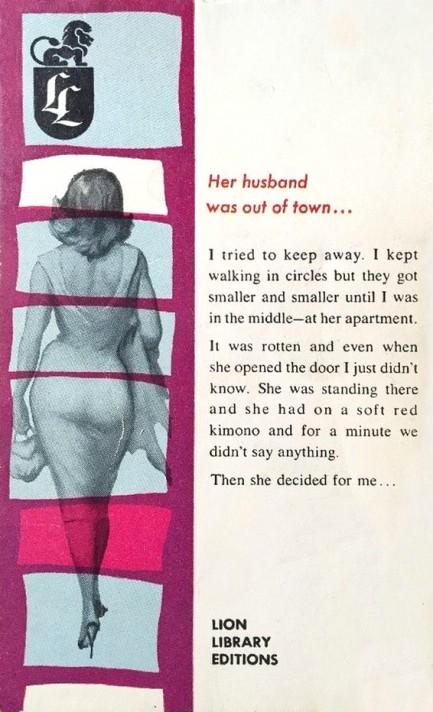 Cross-country train trip runs into heavy snow and cultural headwinds. 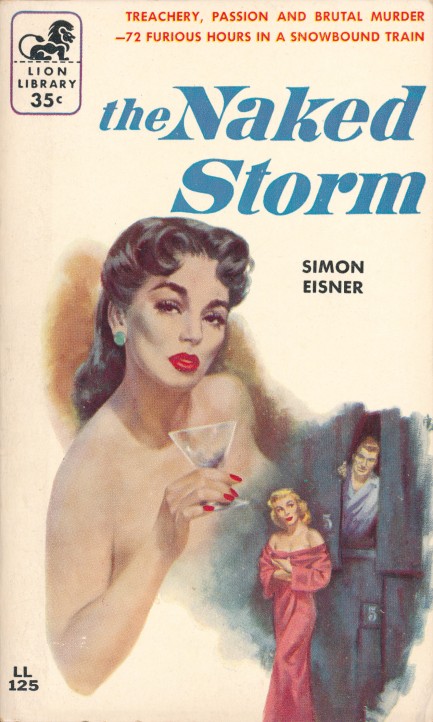
Falling into the category of well-known authors writing lurid fiction under pseudonyms, we have today The Naked Storm by Simon Eisner, from Lion Books in 1956 with a cover by Robert Stanley. Eisner was a cloak for sci-fi author C.M. Kornbluth, who was co-winner of the coveted Hugo Award in 1973 for his short story "The Meeting." The Naked Storm employs as its central plot device a train snowbound on the high Raton Pass during a bitterly cold Colorado winter. Essentially, it's a disaster novel, and you know we always grab those when we can.
This is not the only tale of this ilk Kornbluth was involved with. Perhaps you remember A Town Is Drowning. As is typical of trapped cast novels, a number of ongoing dramas take place here, and these offer windows into mid-1950s sociology. The character unwillingly controlled by organized crime figures, the pretty wife who's a heroin addict, the wide-eyed ingenue, the obese woman carrying a baby that will—shocked, we tell you!—turn out to be brown rather than white, and even the starving wolf that happens upon and begins eating a human body are interesting, but the notable personality here is the predatory lesbian who lacks a single scruple.
For that reason, the novel is an instructive look at the prevalent mid-century belief (which of course never went away in some benighted quarters) that homosexuality is a sickness. While any character can be a villain in fiction, and any character can be a sexual predator, since lesbianism is posited here to be both evil and contagious, the core drama of whether the ingenue will be lured onto track 69 is pure patriarchal hate-mongering. Hilariously, from an authorial point of view, she should choose one of the male characters with whom to bed down. The fact that they're all losers doesn't seem to matter.
So what you get in the end is a textbook example of homophobia in mid-century literature, one that's fit for study, should anyone out there be looking for thesis material. However, it's pretty well written and reasonably engrossing once you slog past the first thirty pages. Also, Kornbluth wrote other books with lgbt themes, such as Half and Sorority House, and because we haven't read them we feel it's only fair to suggest that he may have produced more nuanced, less reactionary work in those (though probably not). Hmm... to read a bigoted novel or not? Serious vintage book fans always face that question. You've been duly informed.
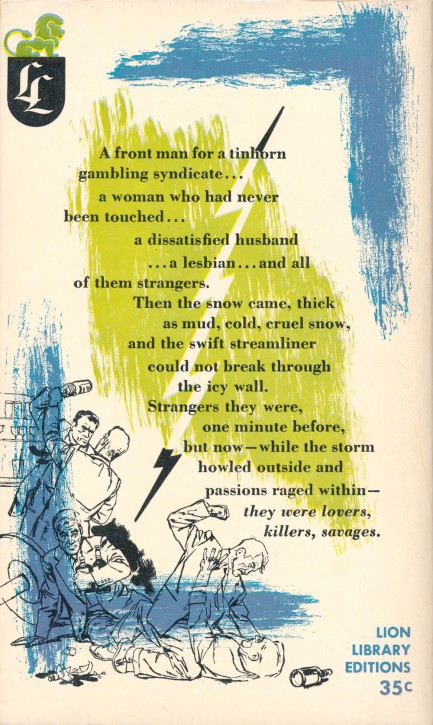
 It's amazing how fast calm can vanish at sea. 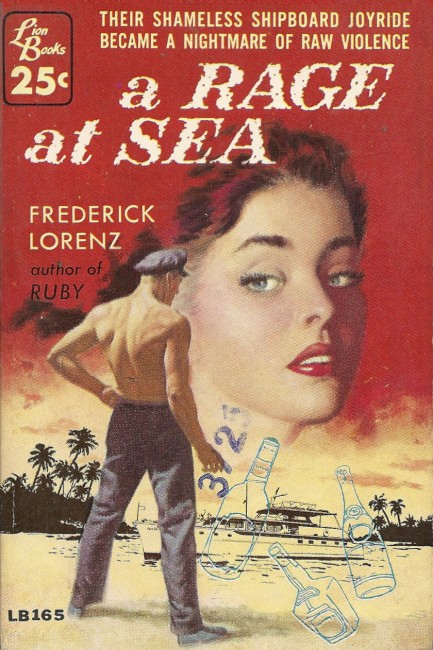
Though James Bama was a major illustrator, we haven't seen much of him here on Pulp Intl. over the years because he painted many fronts for western novels, and we rarely read those. This is his work on the front of Frederick Lorenz's 1957 thriller A Rage at Sea, the story of a down and out charter captain named Frank Dixon who's gone alcoholic after losing his beloved boat in a poker game. He's given a chance at redemption when he's offered a job captaining a yacht from Florida through the Caribbean.
The man paying for the boat is a philandering millionaire, and the person who recommended Dixon for the job is a dangerous and sneaky opportunist perfectly willing to admit that somehow this charter is supposed to lead to the millionaire being bled for his money. Any rational captain would refuse the job, but Dixon wants another boat and the pay he's being offered is a step along that path. It's also a step into a seagoing snakepit, and the situation goes from uncomfortable to terrible when he gets stuck in a life-or-death battle for survival.
We liked the book, but Lorenz does make a misstep or two. For example, there are seven people on the yacht, and while the engineer is an important secondary character, we never get to know—or for the most even really meet—the other guests, which is a narrative choice we consider to be a flaw. Brushing off passengers in a closely confined yacht setting isn't realistic. But we get it—the story Lorenz wanted to tell is one of a man caught between a predator and victim, both of whom are awful people.
On the plus side, the book moves fast, the lines of conflict are propulsive and believable, and the setting and characterizations work. We'll look for more from Lorenz, who was really Lorenz Heller, and under the pseudonyms Lawrence Heller, Larry Holden, and Laura Hale authored intriguingly titled novels such as Hot, Night Never Ends, and A Party Every Night. Hopefully we'll get our hands on one of those and report back.
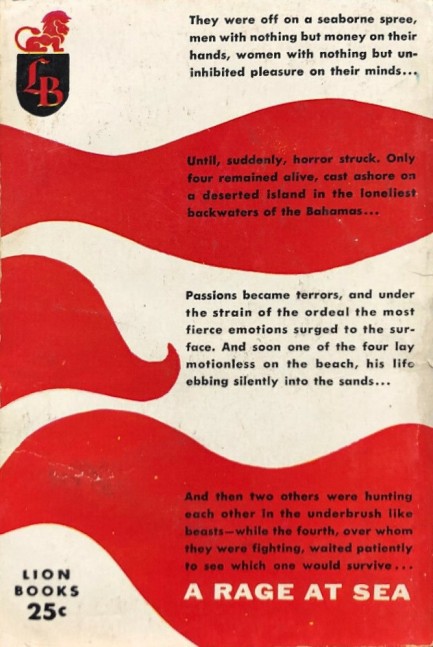
 Hmph. That actually turned out to be a surprisingly easy choice. 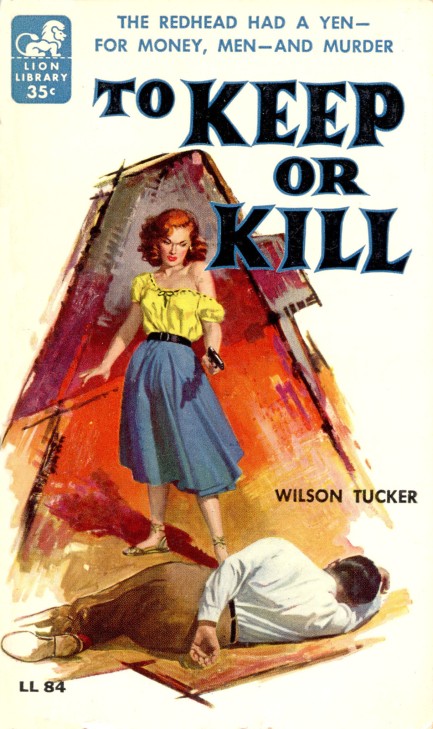
Above: nice Robert Maguire art for Wilson Tucker's novel To Keep or Kill, from Lion Library, 1956. Tucker was primarily a science fiction writer, an acclaimed one, who invented the practice and term, “tuckerization,” which is to borrow a friend's name for a fictional character. This is not to be confused with actually basing a character on a friend. Tuckerization is sort of an in-joke, a nod to someone in one's social circle. Turning back to the cover, this fits nicely into our collections of women who've killed or mortally wounded men, which you can see here and here.
 Don't worry about how my husband would react. He gets mad at everything I do anyway. 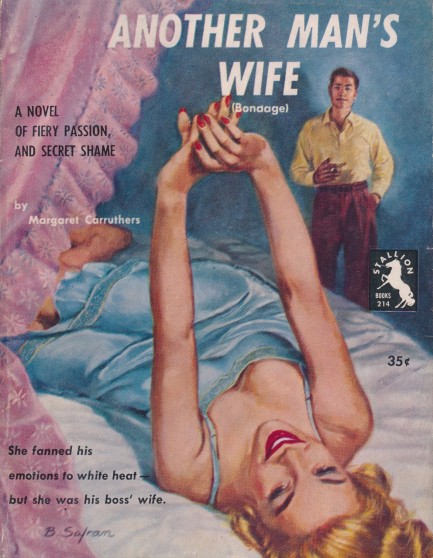
Most of the authors of sleaze or love novels tended to come and go quickly, and Margaret Carruthers, who wrote 1953's Another Man's Wife, is one of those cases. She's also credited with the novel His Best Friend's Wife, but beyond that, and a possible magazine short story, we've got nothing on her. The cover, however, is by the well known and talented Bernard Safran, a painter who isn't in the same class perhaps as paperback digest illustrators like George Gross and Rudy Nappi, but someone whose work we've always liked. This effort, with its beautiful colors and effortless pose, is so good it makes us want to lounge in bed too.
 I really wish you'd answer me just once, honey. Sometimes I feel like you're not even there. 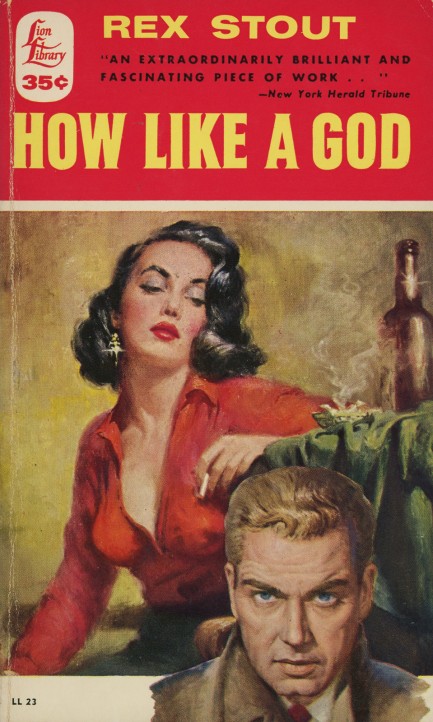
Above is an uncredited cover for Rex Stout's psychological drama How Like a God, with its title referencing Hamlet, and its narrative considered notable for both structure and style. Basically, a man ascends a stairway with the intent to commit murder, and along the way the reader learns his entire life story, as well as who's at the top of the stairs that he intends to kill. In addition, the tale is told in both third and second person, though mostly the latter, so that for most of the story you're reading about yourself. Stout would go on to author the highly successful Nero Wolfe series, which eventually ran to thirty-three entries, and cemented his legacy as one of greats of mystery literature. How Like a God was originally published in 1929, with this Lion edition coming in 1955.
 I'm sort of a paradox. I'm a terrible wife, but I'm incredible at everything that gets a woman a husband. 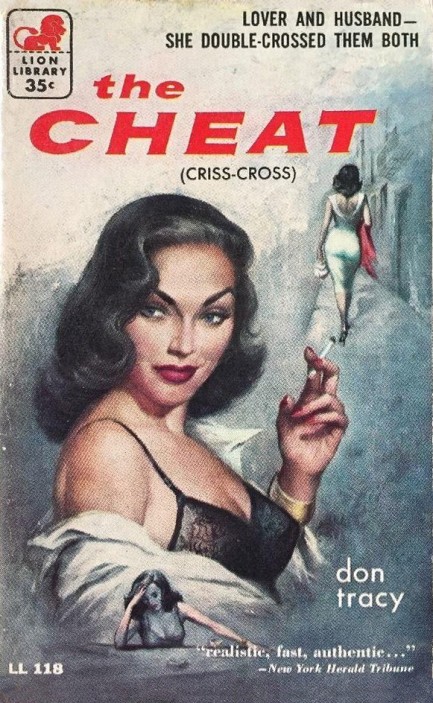
Above is a cover for Don Tracy's novel The Cheat, originally published as Criss-Cross in 1934, with this Lion edition coming in 1956 with Charles Copeland cover art. This is a good book, but if you're seeking artful prose you might as well keep looking. 1934 was early in the game for hard-boiled fiction. A few authors were doing visionary work but the form was still establishing its parameters. What attracted readers was that these were new types of stories—frank, violent, and centered around hard luck protagonists, ruthless villains, and women who were to varying degrees breathtakingly beautiful, sexually ravenous, and totally amoral.
The Cheat is about a boxer named Johnny Thompson. The Depression has drained the profit from boxing, so for the moment Johnny is an armored car guard, riding shotgun for payroll deliveries. He's occasionally going out with Anna, who's far too beautiful for the likes of him and mainly just likes to have money spent on her. Johnny doesn't have much of that, which means he has no real shot with Anna. He coasts along in financial and romantic limbo until Anna breaks his heart by suddenly marrying a neighborhood slickster named Slim Dundee.
So many of these pulp novels hinge upon sex, but it couldn't be explicitly stated. Tracy is fairly clear about it here, though. Johnny thinks he's ugly yet refuses to consort with women he considers to be of inadequate quality, so he's sexually inexperienced. He isn't a virgin, but it's been years since his first couple of sexual encounters. Anna is his unattainbale dream. He's never even kissed her, but her willingness to associate with him provided his life with hope. He lost that when she married, but she later shocks him by finally offering herself to him, vows be damned. We get a clear sense of what it means to Johnny:
I bit my knuckles thinking about it and how sweet—oh my God—it would be, but I wouldn't take it. [snip] Every hour was full of pictures of Anna. Anna as I'd seen her and Anna as I'd never seen her, but could if I went there the next night. Anna, naked. Anna, in my arms, looking up at me. I kept seeing her and feeling her body under me and her open mouth on my mouth.
So hot she makes him bite his knuckles. That's hot. Johnny virtually flogs himself, telling himself not to give in, not to betray Slim, not to accept Anna's baffling out-of-the-blue offer, but it's useless of course. He goes, she meets him at the door in a kimono and nothing else, his fuses all blow, and nature takes its course:
I remember sobbing, although I wasn't really crying, when the first deep contentment began to rub out the ache I'd had in me for so long.
Well, that gets to the point. And it's a point we've been making for years. These guys don't get into trouble because of mere sex. They get into trouble because of sex as they never imagined it could be—in this case sex that makes him “not really” cry. Yowsa. His reaction has largely to do with finally attaining what he thought he was not good enough to have, in effect validating his entire existence, but there's no doubt the heights of sheer physical pleasure bring it on too. We picture him drying his wet eyes with a corner of the sheet and telling Anna, “I'm sorry. It's not you, it's me.” Needless to say, he's hooked, and who wouldn't be?
During subsequent sessions Anna keeps her, ahem, guard up, and Johnny enjoys every moment, despite feelings of guilt for being a backstabber. Then comes the pivotal day when Slim approaches him with an idea to rob the armored car—with Johnny as the inside man. Anna is on board with the plan, so clearly if he refuses she might not let him be her inside man anymore. Where it goes from there we won't reveal. We'll only say that The Cheat overcomes its rudimentary feel and provides considerable entertainment, which is the next best thing to actually being well written. And for those who enjoy their crime thrillers with motion and sound, a pretty good movie was made of it in 1949. Chose either or both. You'll win regardless.
 Excuse me, fellas, gotta go. Fleeting joy, followed by stinging disappointment and eventual doom are beckoning. 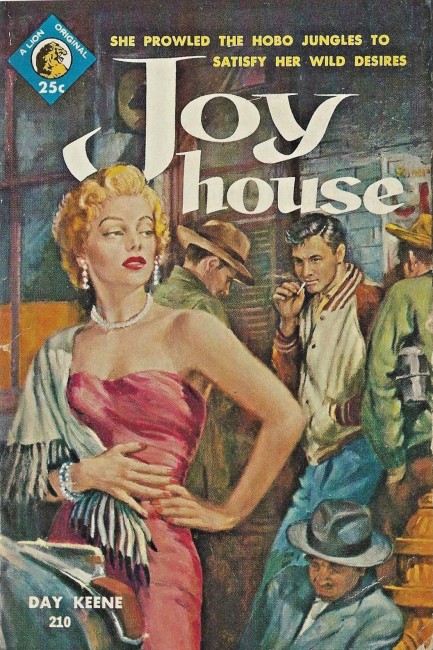
When you write more than fifty novels it helps to be highly imaginative, and Day Keene puts his brain through its paces in 1954's Joy House, a bizarre tale about a flashy mob lawyer named Mark Harris who flees his West Coast employers, wakes up in a Chicago mission after a five-week drinking binge, and is scooped up by a beautiful do-gooder widow who lives in a boarded up mansion. The widow became a recluse years earlier when her husband was murdered, and now all she does is take food to the mission three times a week, but when Harris moves into her house he awakens her dormant love glands and the two start really heating up the old pile of bricks.
As long as Harris keeps a low profile his pursuers won't have success, but he and the widow become increasingly public—something Harris can't avoid because he hasn't been truthful about hiding from mobsters who want to kill him. Luckily for him, she wants to start life anew, and suggests moving to Rio de Janeiro. Excellent idea, but there's more going on than Harris knows. As imaginative as this story is, it could have been better written—a hazard when you publish seven other novels in the same year—but overall we liked it. We like the uncredited cover too. We'll have more from Keene later. After all, with fifty-plus novels to his credit, he's almost unavoidable.
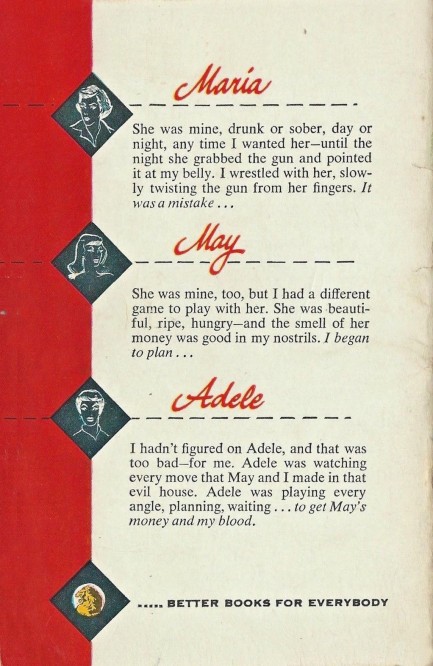
 You're going burgling again, aren't you? Don't lie to me, buster. I always know the signs. 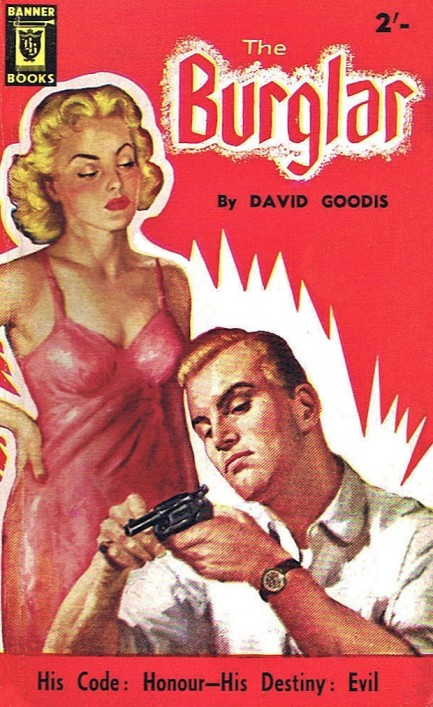
David Goodis's novel The Burglar is one of our recent favorites. Above is a nice edition from Banner Books, which we gather was a British sub-imprint of Lion Books, but one that must not have been around long, since we can't locate any mention of it except in the seller's auction. Indeed, the vendor could simply be wrong. It happens. The art on this is uncredited. You can read our rave of the novel here. Update: the May 1955 cover of Justice you see below is attributed to Julian Paul, so that solves the mystery of The Burglar.
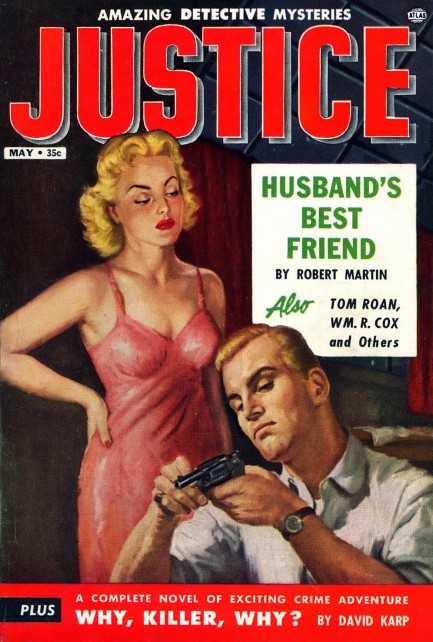
 Nightfall is the time when desperate men commit desperate acts. 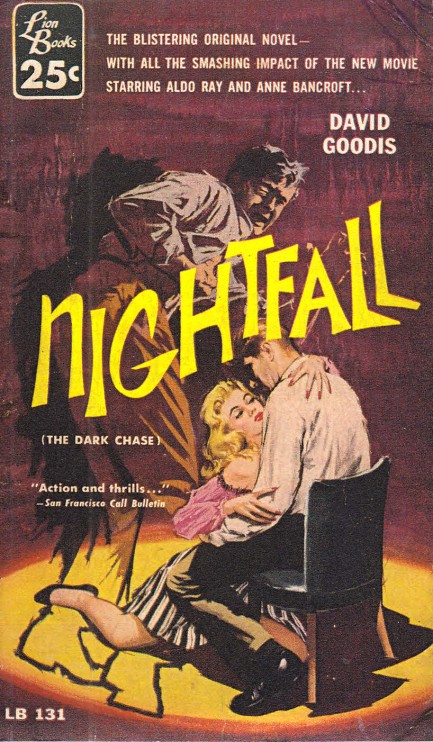
David Goodis was one of the mid-century era's most successful crafters of crime fiction. Movies based on his books include Dark Passage, the visually dazzling 1983 French film La lune dans le caniveau (The Moon in the Gutter), and the brilliant thriller The Burglar. His drama Nightfall, aka The Dark Chase, tells the story of a man who stumbles upon bank robbers, comes into possession of their loot, but loses it in a wild panic while fleeing a shooting. Months later and many states away, he's trying to make a new life but soon learns cops are trailing him trying to solve the robbery, and the surviving bank robbers have surfaced to demand the cash. He'd better find it or he's mega-screwed, but he literally can't remember what happened to it. He's blacked it out. Like other Goodis novels Nightfall became a movie, though it's hard to see cinema in it when you read it. But Jacques Tourneur had no issues, crafting a 1956 film noir starring Aldo Ray and Anne Bancroft. For us the novel, with its hallucinatory nature and quasi-amnesiac protagonist, wasn't a top thriller, but it was satisfying enough. This Lion Books edition came in 1956 with uncredited cover art.
 Some girls just can't get enough dock. 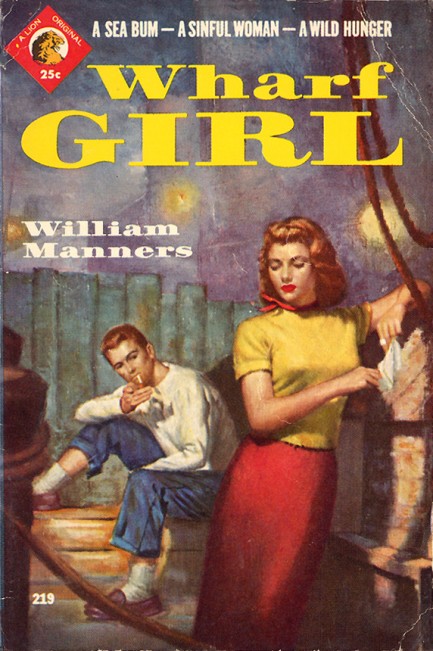
We said recently that untamable girls on the waterfront were an oft used trope in mid-century literature, and since then we keep running across examples. 1954's Wharf Girl by William Manners is another to add to the list. There are actually a few women involved here, according to the rear cover, a Stella, a Kathy, and a Barby, but the actual wharf girl seems to be Stella. We suppose that's her in the uncredited cover art. We can't tell you more without buying the book, and well, that isn't going to happen because the shipping costs for this are out of control. Plus we already have something like two-hundred novels to read. That's not a typo. Will we ever get to them? Well, our city is back in quarantine, so we have a lot more free time now.

|
 |

The headlines that mattered yesteryear.
1939—Holiday Records Strange Fruit
American blues and jazz singer Billie Holiday records "Strange Fruit", which is considered to be the first civil rights song. It began as a poem written by Abel Meeropol, which he later set to music and performed live with his wife Laura Duncan. The song became a Holiday standard immediately after she recorded it, and it remains one of the most highly regarded pieces of music in American history. 1927—Mae West Sentenced to Jail
American actress and playwright Mae West is sentenced to ten days in jail for obscenity for the content of her play Sex. The trial occurred even though the play had run for a year and had been seen by 325,000 people. However West's considerable popularity, already based on her risque image, only increased due to the controversy. 1971—Manson Sentenced to Death
In the U.S, cult leader Charles Manson is sentenced to death for inciting the murders of Sharon Tate and several other people. Three accomplices, who had actually done the killing, were also sentenced to death, but the state of California abolished capital punishment in 1972 and neither they nor Manson were ever actually executed. 1923—Yankee Stadium Opens
In New York City, Yankee Stadium, home of Major League Baseball's New York Yankees, opens with the Yankees beating their eternal rivals the Boston Red Sox 4 to 1. The stadium, which is nicknamed The House that Ruth Built, sees the Yankees become the most successful franchise in baseball history. It is eventually replaced by a new Yankee Stadium and closes in September 2008.
|

|
|

It's easy. We have an uploader that makes it a snap. Use it to submit your art, text, header, and subhead. Your post can be funny, serious, or anything in between, as long as it's vintage pulp. You'll get a byline and experience the fleeting pride of free authorship. We'll edit your post for typos, but the rest is up to you. Click here to give us your best shot.

|
|














